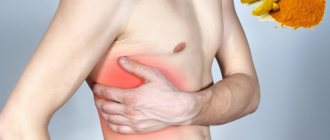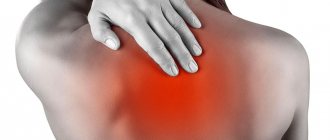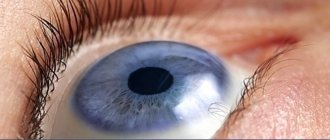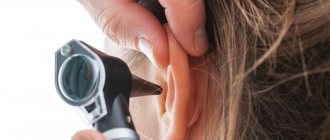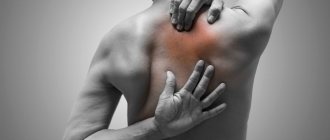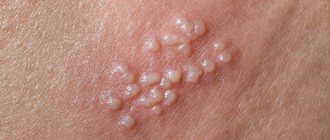Intercostal neuralgia
This is a pain syndrome caused by damage to the peripheral nerves of the chest. Appears due to inflammation, irritation or pinching of the nerve roots in the intercostal space. Intercostal neuralgia is not a disease - it is a syndrome that can appear against the background of various pathologies. Vertebrogenic thoracalgia (as intercostal neuralgia is called) is a general concept that refers to pain that occurs in the chest area. They can appear for no particular reason, or can serve as a sign of various diseases.
Symptoms may resemble pain from a heart attack, pneumonia or pleurisy, diseases such as pancreatitis and others. A characteristic symptom is an increase in pain when coughing, laughing, moving, bending the body and decreasing at rest and with muscle relaxation. This is a distinctive feature of intercostal neuralgia, which allows it to be differentiated from symptoms of heart disease or other pathologies. But you shouldn’t take risks and try to diagnose yourself. The cost of a mistake can be higher than the prolonged pain syndrome.
The principles of treatment and symptoms of intercostal neuralgia in men and women are similar. The main manifestation is pain:
- Paroxysmal, occurring on its own.
- Monotonous, aching.
- Intensified by movement, deep breathing and exhalation, laughter, coughing.
- Occurs when pressing on individual points on the front of the chest or side.
- A burning sensation in the area where the nerve is damaged.
- Numbness, “pins and needles” sensation.
The pathology is more common on the left side of the body, and in women, intercostal neuralgia is a fairly common companion to pregnancy. During this period, the growing fetus puts pressure on the organs in the abdominal cavity, which can lead to pinched nerves.
Why is intercostal neuralgia on the right dangerous?
The danger of right-sided neuralgia is its insidiousness, because it often disguises itself as other diseases . It is not always immediately recognizable and is often confused with angina pectoris and other heart ailments.
How not to confuse it with other diseases?
Pay attention to how not to confuse intercostal neuralgia with angina pectoris and other diseases of internal organs. There are several signs that you need to focus on when differentiating neuralgia:
- With heart problems, acute pain sensations are not so long-lasting, they last up to a maximum of a third of an hour.
- Nitroglycerin helps relieve this suffering.
- Heart pain covers a wide area, usually including the heart, arm and shoulder.
- The nature of such pain does not change with movement, coughing, sneezing, and it is not associated with breathing.
- In this case, the heart rhythm is still disturbed.
It is even easier to confuse neuralgia with a stomach ulcer ; the symptoms, intensity, duration of pain and its nature are similar in both cases. The difference is that in case of stomach disease, no-spa comes to the rescue, relieving pain and spasm, but in case of intercostal neuralgia this remedy is useless.
But in any case, for acute pain, home treatment is contraindicated; it is not effective, but by getting carried away with it, you can waste time and thereby contribute to the complication of the disease.
Video: “How to distinguish intercostal neuralgia from heart disease?”
Find out more about diagnosing intercostal neuralgia in the following articles:
- Causes of intercostal neuralgia in women and symptoms of the disease
- How and why intercostal neuralgia occurs during pregnancy is described here
- How not to confuse left intercostal neuralgia with heart disease, you will learn on the page
Causes
Intercostal neuralgia can be caused by various reasons. Basic:
- Poor posture, injuries, intervertebral hernias, osteochondrosis.
- Hypothermia, which led to poor circulation.
- Infectious and other diseases that lead to nerve damage. For example, destruction of the nerve sheath in multiple sclerosis.
- Neoplasms that compress nerve roots.
- Muscle spasms, prolonged tension during sudden movements or prolonged uncomfortable body posture.
- Operations.
- Pathologies of internal organs.
Diagnostics
Intercostal neuralgia can be a symptom of many diseases - from cardiovascular pathologies to diseases of the internal organs of the abdominal cavity and chest. It is impossible to independently determine the cause only from existing complaints. A consultation with a neurologist and a comprehensive diagnosis is necessary to ensure that there are no diseases of the heart, lungs, or digestive system.
Particular attention is paid when diagnosing and treating intercostal neuralgia on the left side. Acute pain in the heart may be a sign of a heart attack. Symptoms usually differ - for example, with heart problems, cold sweat appears and shortness of breath bothers you, the pain does not decrease with rest when the muscles relax. But making a diagnosis based only on symptoms is wrong. The doctor is responsible for the life and health of the patient, which means he needs confidence in the diagnosis and correctness of treatment.
The procedure for examining a patient with suspected intercostal neuralgia is as follows:
- Questioning the patient about complaints and the characteristics of their occurrence.
- Examination to find the location of the pain.
- Setting up a preliminary diagnosis.
- Carrying out examinations to confirm intercostal neuralgia, its causes and prescribe the treatment that will be required in a particular case.
The following diagnostic methods can be used:
- Magnetic resonance imaging or computed tomography is a study that will provide detailed and highly accurate images of tissues and pathology in them.
- ECG – monitoring of heart function to exclude cardiovascular diseases.
- Ultrasound of the heart or other internal organs, diseases in which may have similar symptoms.
- X-ray of the lungs to exclude pneumonia, pleurisy and other diseases in which there are complaints of chest pain.
Diagnostic methods are selected individually depending on the nature of the pain and its location, and the patient’s condition. In some cases, other specialists are involved in diagnosis and treatment - a cardiologist, gastroenterologist, pulmonologist.
Symptoms and signs of the disease
The main manifestation of intercostal neuralgia is acute and burning pain along the intercostal nerves, sometimes intensifying in paroxysms, especially with movement, with turns of the body, with deep breathing, coughing and sneezing. When feeling and during palpation of the spine and intercostal spaces, their sharply increased sensitivity and pain are recorded, corresponding to the affected segment. The pain that occurs with intercostal neuralgia is constant, encircling in nature, forcing the patient to take a forced position, in which the patient bends the body in the healthy direction, trying to maintain it. The pain syndrome lasts from several hours to several days. Sometimes there is a feeling of numbness and a sensation of “pins and needles” in the affected area.
How to distinguish intercostal neuralgia from heart pathologies?
Symptoms of intercostal neuralgia, often simulating lesions of the cardiovascular system, can be mistakenly regarded as a heart attack. For example, pain in the heart area radiating to the left shoulder blade is a sign that can only be associated with the presence of wide branches of nerves in the intercostal space.
You need to know that with pain felt in the retrosternal region associated with a disturbance in the functioning of the heart, there are necessarily changes in blood pressure and pulse rhythm. Such a connection is absent with intercostal neuralgia, and the pain is of a girdling nature. Neuralgia pain is not relieved by nitroglycerin. In addition, changes in body position during heart disease will not affect the nature of the pain. But if the intercostal nerves are pinched, the pain will worsen with sudden movement, coughing, sneezing, or deep breathing.
At the same time, you need to know that myocardial infarction with extensive damage to the heart muscle can cause pain, which increases with movement and does not decrease when taking heart medications, which makes it difficult to diagnose the disease.
In some cases, the nature of the pain resembles the pain associated with renal colic. This occurs when the nerves of the lower ribs are affected, when there is a sudden sharp, cramping pain in the lumbar region, which radiates to the leg or groin area.
If chest pain occurs, which can be one of the symptoms of a number of life-threatening, serious diseases, it is certainly necessary to consult a doctor. Therefore, in no case should you prescribe treatment for yourself; you should not hesitate, but you should immediately seek medical help.
Treatment
The goals of therapy for intercostal neuralgia: reduce pain, eliminate the cause of pinching or inflammation.
For this purpose, drug treatment is prescribed using:
- Muscle relaxants to relieve muscle spasms.
- Neuroprotectors for the protection and restoration of nerve cells.
- Painkillers and injection therapeutic blockade with various drugs. It has a strong analgesic effect, relieves swelling and eliminates muscle spasms.
Drug treatment of intercostal neuralgia is complemented by physiotherapy. The following physiotherapeutic procedures can be used:
- Exercise therapy is an individually selected set of exercises to relax spastic muscles, improve blood circulation and lymph flow in the problem area. Exercise therapy is effective for the treatment and prevention of neuralgia, but it can only be done if there are no contraindications. It is important not to cause harm, which is possible with home exercises. What exercises will be effective, how exactly to do them, the number of repetitions - all this will be advised by a physical therapy doctor. The safest and most effective classes are under the supervision of a physical therapy instructor in individual or group classes.
- Laser therapy uses light energy to increase blood circulation, relax muscles, and reduce pain and inflammation.
- Magnetotherapy - the effect of an electromagnetic field on the body leads to the elimination of congestion, improvement of blood circulation, and reduction of pain syndromes.
- Diadynamic therapy, galvanization, exposure to interference currents and other procedures with electric current of varying power and frequency. They have a healing effect on soft tissues, improving blood circulation and lymph outflow, relaxing muscles and providing an analgesic effect.
- Electrophoresis is a procedure that improves the penetration of drugs into soft tissues and accelerates their action.
- Therapeutic massage and manual therapy are methods of influencing the body with the hands of a doctor. They allow not only to reduce or completely relieve pain, but also to treat the causes of intercostal neuralgia - pathologies of the spine, functional blocks in its work. What exactly to use - acupressure, segmental or other types of massage - is decided by a chiropractor or massage therapist.
- Acupuncture (acupuncture) – injections with thin needles into biologically active points on the body to relieve pain and normalize the functioning of internal organs.
Treatment of intercostal neuralgia on the right or left side of the chest, in the side with the help of physiotherapeutic procedures is carried out in several procedures. A full course usually consists of 10-15 sessions. Appointments are always individual.
Prevention
The following recommendations help to avoid the appearance of intercostal neuralgia:
- Moderate physical activity to strengthen the muscle frame and maintain their elasticity.
- Maintaining correct posture.
- Healthy eating.
- Daily routine and alternation of work and rest time.
- Protection against hypothermia.
You should not endure the pain of intercostal neuralgia and worry about its causes - consult a doctor to be sure that there are no serious pathologies and for quick relief of symptoms.
Pain or heaviness in the right hypochondrium
Hepatitis
Jaundice
Vomit
32169 05 April
IMPORTANT!
The information in this section cannot be used for self-diagnosis and self-treatment.
In case of pain or other exacerbation of the disease, diagnostic tests should be prescribed only by the attending physician. To make a diagnosis and properly prescribe treatment, you should contact your doctor. Pain or heaviness in the right hypochondrium: causes of occurrence, what diseases it occurs with, diagnosis and treatment methods.
Definition
The right hypochondrium is one of nine areas into which the anterior abdominal wall is conventionally divided. This area belongs to the so-called “upper floor” of the abdominal cavity.
In the right hypochondrium there are the liver, gallbladder, hepatic angle of the colon, and swollen loops of the small intestine can also be projected into this area. The organs listed above belong to the digestive system.
The liver is a parenchymal (spongy) organ with a very good blood supply. The outside of the liver is covered with a capsule in which nerve endings are located. The liver is involved in the metabolism of proteins, fats, carbohydrates, vitamins, and plays a vital role in detoxification of the body.
Harmful substances that enter the liver are subjected to “chemical” processing, which makes them less toxic to the body and promotes faster elimination through the gastrointestinal tract and urine.
In addition, liver cells produce bile necessary for digesting food, primarily fats. Bile enters the gallbladder, located on the lower surface of the liver, where bile accumulates, which is released from it into the duodenum during the next meal.
From above, the liver is adjacent to the diaphragm - a kind of muscular partition between the abdominal and thoracic cavities. From below, from the side of the abdominal cavity, the diaphragm is lined with peritoneum (which covers the entire abdominal cavity and organs located in it from the inside), and from above, from the side of the lungs, by the pleura, which lines the pleural cavity from the inside and covers the lungs from the outside. Both the pleura and peritoneum have good innervation, which is important to know to understand the causes of pain and heaviness in the right hypochondrium. The peritoneum also covers the gallbladder and intestinal loops.
Types of pain or heaviness in the right hypochondrium
The pain in the right hypochondrium can be acute, sometimes “dagger-like”, which makes you think about a serious illness. This pain is characteristic of hepatic colic and is often accompanied by nausea, vomiting, increased sweating, increased heart rate and a drop in blood pressure.
In chronic diseases and the gradual development of acute diseases, the pain is often dull, bursting in nature, or is described by the patient as “heaviness, discomfort” in the area of the right hypochondrium.
Pain syndrome can be spontaneous, or it can be provoked by food intake, alcohol, physical activity, change in body position, etc.
Possible causes of pain or heaviness in the right hypochondrium
There is only one mechanism for the development of pain: stimulation of pain receptors. As mentioned above, the peritoneum has good innervation. Also, a large number of nerve endings are localized in the wall of hollow organs (intestines, gall bladder). Therefore, inflammatory processes in these organs naturally manifest themselves as pain.
Pain also occurs when the liver capsule is stretched. This can occur due to an increase in the volume of the organ (which in most cases is associated with tissue swelling), due to the accumulation of any fluid (most often blood) under the capsule (with a traumatic rupture of the liver), or damage to the capsule.
Unpleasant sensations in the area of the right hypochondrium are caused by excessive distension of the intestinal loops by intestinal contents or gases. In addition, since the organs of the chest are located close to the right hypochondrium, in case of development of pleurisy (inflammation of the pleura), the pain syndrome can also be localized in the right hypochondrium and imitate diseases of the abdominal organs.
Diseases that cause pain or heaviness in the right hypochondrium
Among acute diseases accompanied by pain in the right hypochondrium, it is worth mentioning first of all those that require emergency surgical intervention.
These include
acute calculous cholecystitis
and
renal colic
.
Both conditions are a consequence of cholelithiasis
. Inflammation of the gallbladder (cholecystitis) develops against the background of an already advanced process of stone formation or, conversely, is the cause of the formation of stones. With renal colic, a calculus (stone) becomes wedged into narrow segments of the biliary tract, which is accompanied by severe pain, impaired bile outflow, and in more severe cases – jaundice (yellowing of the sclera and skin).
Other diseases of the biliary tract, such as
biliary dyskinesia
,
chronic cholecystitis
, cause recurrent pain in the right hypochondrium, usually associated with an error in diet.
Another disease classified as an “acute abdomen” that can cause pain in the right hypochondrium is appendicitis.
(inflammation of the appendix).
Despite the fact that the classic position of the appendix corresponds to the right iliac region, an abnormal position of the appendix in the right hypochondrium is quite common, especially in children.
Overdistension of intestinal loops can develop as part of
intestinal obstruction
.
Swelling of the liver tissue is characteristic of hepatitis (inflammation of the liver parenchyma). Hepatitis can have a variety of origins: viral hepatitis A, B, C, etc., autoimmune, toxic, incl. alcoholic. These diseases are usually accompanied by pain, as well as weakness, nausea and vomiting, yellowing of the skin and sclera, change in the color of urine and feces.
Subcapsular hematomas of the liver (accumulation of blood between the liver tissue and its capsule), as well as ruptures of the liver capsule, are usually traumatic in nature.
Among the diseases of the chest that can cause pain in the right hypochondrium, it is worth mentioning pleuropneumonia (inflammation of the lung tissue and pleura), heart failure, intercostal neuralgia and herpes zoster. The latter is characterized by the appearance of blistering-type skin rashes, which are preceded by severe pain.
Which doctors should you contact if you experience pain or heaviness in the right hypochondrium?
If sudden, progressively increasing pain appears in the area of the right hypochondrium, you should contact a doctor to exclude acute surgical pathology. If the pain is not acute, the examination can begin at or. If necessary, the patient can get advice from a hepatologist (a specialist in liver diseases) and other specialized specialists.
Diagnostics and examinations for pain or heaviness in the right hypochondrium
After a detailed survey and comprehensive clinical examination, the doctor, as a rule, needs laboratory and instrumental confirmation of the diagnosis. For this purpose, the following studies are used:
- A clinical blood test with determination of the leukocyte formula, based on the results of which one can suspect the presence of an inflammatory process in the body and determine its severity.
